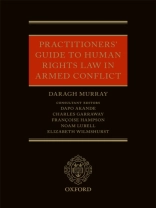Although the relationship between international human rights law and the law of armed conflict has been the subject of significant recent academic discussion, there remains a lack of comprehensive guidance in identifying the law applicable to specific situations faced by military forces. Providing guidance for armed forces and practitioners on the detailed application of international human rights law during armed conflict, this book fills that gap. Part 1 of the volume details foundational information relating to international human rights law and human rights institutions, the types of operations that States’ armed forces engage in, and how the law of armed conflict and international human rights law apply to regulate different situations. Part 2 provides practical guidance as to the legal regulation of specific situations, including discussion of the conduct of hostilities, detention operations, humanitarian assistance, cyber operations, and investigations. This book is the result of an in-depth process involving both academic and practitioner experts in the law of armed conflict and international human rights law who were convened in meetings at Chatham House chaired by Elizabeth Wilmshurst, Distinguished Fellow at Chatham House. The group included Professor Francoise Hampson, Essex University; Professor Dapo Akande, Oxford University; Charles Garraway, Fellow at Essex University; Professor Noam Lubell, Essex University; Michael Meyer, British Red Cross; and Daragh Murray, Lecturer at Essex University.
Daragh Murray
Practitioners’ Guide to Human Rights Law in Armed Conflict [EPUB ebook]
Practitioners’ Guide to Human Rights Law in Armed Conflict [EPUB ebook]
Купите эту электронную книгу и получите еще одну БЕСПЛАТНО!
язык английский ● Формат EPUB ● страницы 325 ● ISBN 9780192508928 ● редактор Dapo Akande & Charles Garraway ● издатель OUP Oxford ● опубликованный 2016 ● Загружаемые 3 раз ● валюта EUR ● Код товара 5281774 ● Защита от копирования Adobe DRM
Требуется устройство для чтения электронных книг с поддержкой DRM












